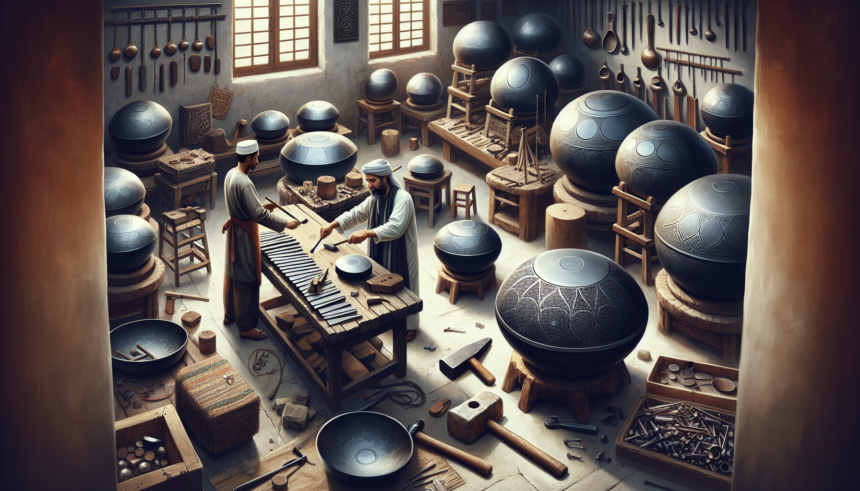The world of handpan instruments is a unique and mesmerizing realm. The soothing, ethereal sounds these instruments produce have captivated musicians and listeners alike. Yet, the artistry behind creating a handpan is a meticulous and labor-intensive process that remains largely hidden from the public eye. This article delves into the detailed craftsmanship and dedication that goes into making these exquisite instruments, offering an exclusive glimpse behind the scenes of handpan workshops.
The Birth of a Handpan
The journey of a handpan begins with high-quality steel sheets. Makers often use either raw steel, nitrided steel, or stainless steel, each bringing its own unique characteristics to the final sound. The first step in creation is to shape these sheets into a shell. This is done using a combination of heat and pressure, meticulously forming the distinct dome-like structure that is iconic to handpans.
Hammering the Harmonies
Once the shell is prepared, the next crucial step involves hammering. This is where the skill and artistry of the maker are truly showcased. Using various hammers and tools, the maker will begin to form the tone fields, the specially-shaped areas of the handpan that produce sound. Each strike must be precise, as inconsistencies can lead to undesirable tones.
While modern technology allows some makers to use machines for this process, many prefer the traditional hand-hammering technique. This method, albeit time-consuming, allows for greater control over the final sound quality and imbues each handpan with a unique character. The expertise required at this stage cannot be overstated, as even seasoned makers continually refine their technique.
Tuning: A Symphony of Precision
Following the hammering stage, the handpan undergoes the meticulous process of tuning. This involves adjusting the tension and contour of the tone fields to achieve the desired pitch and timbre. Makers utilize electronic tuners, tuning forks, and their own ears to fine-tune each note. The process is iterative, requiring patience and precision to ensure each note harmonizes perfectly with the others.
Some makers integrate a process known as nitriding to treat the steel surface, enhancing the instrument’s resistance to rust while subtly influencing the tone’s sustain and warmth. This post-tuning treatment adds an extra layer of complexity, requiring additional careful adjustments to maintain the instrument’s perfect tuning.
The Final Touches: Crafting Aesthetic Beauty
A handpan is not just an auditory delight but also a visual masterpiece. The final stages of the creation process involve adding aesthetic elements. Makers may choose to engrave or etch intricate designs onto the surface, a skill that demands both artistic vision and steady hands. These designs range from simple patterns and logos to elaborate, personalized motifs that resonate with the intended player.
Additionally, some workshops apply protective coatings or finishes to enhance durability and visual appeal. Whether it’s a glossy sheen or a subtle matte finish, these layers must be applied evenly and meticulously to ensure both beauty and longevity.
A Symphony of Collaboration
The creation of a handpan is often a collaborative effort. In many workshops, a team of artisans works together, each bringing their specialized skills to the table. This collaboration does not only streamline the process but also enriches the final product with a blend of creativity and expertise. Veteran craftsmen mentor newcomers, passing on traditional techniques while also embracing innovative methods.
Moreover, handpan communities worldwide are tightly-knit, with makers often sharing insights, techniques, and even tools. This spirit of collaboration extends to musicians who provide invaluable feedback, helping makers refine their craft and push the boundaries of what these instruments can achieve.
Challenges and Triumphs
The path to creating a flawless handpan is fraught with challenges. Makers must navigate the intricacies of metallurgy, acoustics, and craftsmanship. Steel is a notoriously difficult material to work with, requiring both brute strength and delicate precision. Machinery issues, inconsistencies in materials, and the inherent complexity of handpan acoustics all present hurdles that makers must overcome.
Despite these challenges, the triumphs are profound. The moment an instrument produces its first harmonious note is an unparalleled reward for the maker’s efforts. Each finished handpan is a testament to the maker’s skill, creativity, and perseverance, ready to embark on a new journey with its player.
The Global Impact: Connecting Cultures and Hearts
Handpans have transcended their origins to become global instruments, beloved by musicians and listeners across continents. Workshops around the world contribute to this vibrant tapestry, each infusing their heritage and ingenuity into their creations. From Asia to Europe, Africa to the Americas, handpans are celebrated for their ability to bridge cultures and foster a sense of unity.
The handpan community itself is a testament to this global connection. Makers and musicians from diverse backgrounds come together, sharing their passion and knowledge. This cross-cultural exchange enriches the art form, leading to innovations that continually elevate the handpan’s expressive potential.
Conclusion
The world of handpan making is a testament to the blend of art, science, and dedication. Each handpan represents countless hours of skilled labor, creativity, and passion. By delving into the workshops of these talented makers, we gain a deeper appreciation for the beauty and complexity of these extraordinary instruments. Whether you are a musician, a music lover, or someone with a curiosity for craftsmanship, the journey of the handpan offers a profound insight into the boundless possibilities of human creativity.
FAQs
1. What materials are used to make a handpan?
Handpans are typically made from high-quality steel sheets, which can be raw steel, nitrided steel, or stainless steel. Each type of steel offers different characteristics that influence the final sound and durability of the handpan.
2. How long does it take to make a handpan?
The time required to create a handpan varies depending on the maker and the complexity of the design. Generally, it can take anywhere from several weeks to a few months to complete a handpan, from shaping the shells to the final tuning and finishes.
3. Why is hand-hammering preferred by some makers?
Hand-hammering allows makers to have greater control over the shaping and tuning of the tone fields. This traditional method imbues each handpan with a unique character and enables the maker to achieve precise tonal quality. It is a labor-intensive process that showcases the maker’s artistry and expertise.
4. Can handpans be customized?
Yes, many handpan makers offer customization options, allowing players to choose specific scales, aesthetics, and sometimes even engravings. Custom handpans are created to meet the player’s unique preferences and style, making each instrument truly one-of-a-kind.
5. How do handpan makers ensure the instruments are perfectly tuned?
Handpan makers use a combination of electronic tuners, tuning forks, and their own trained ears to achieve perfect tuning. The process involves adjusting the tension and shape of the tone fields iteratively until the desired pitch and harmonics are achieved. This meticulous tuning process is critical to the instrument’s overall sound quality.





